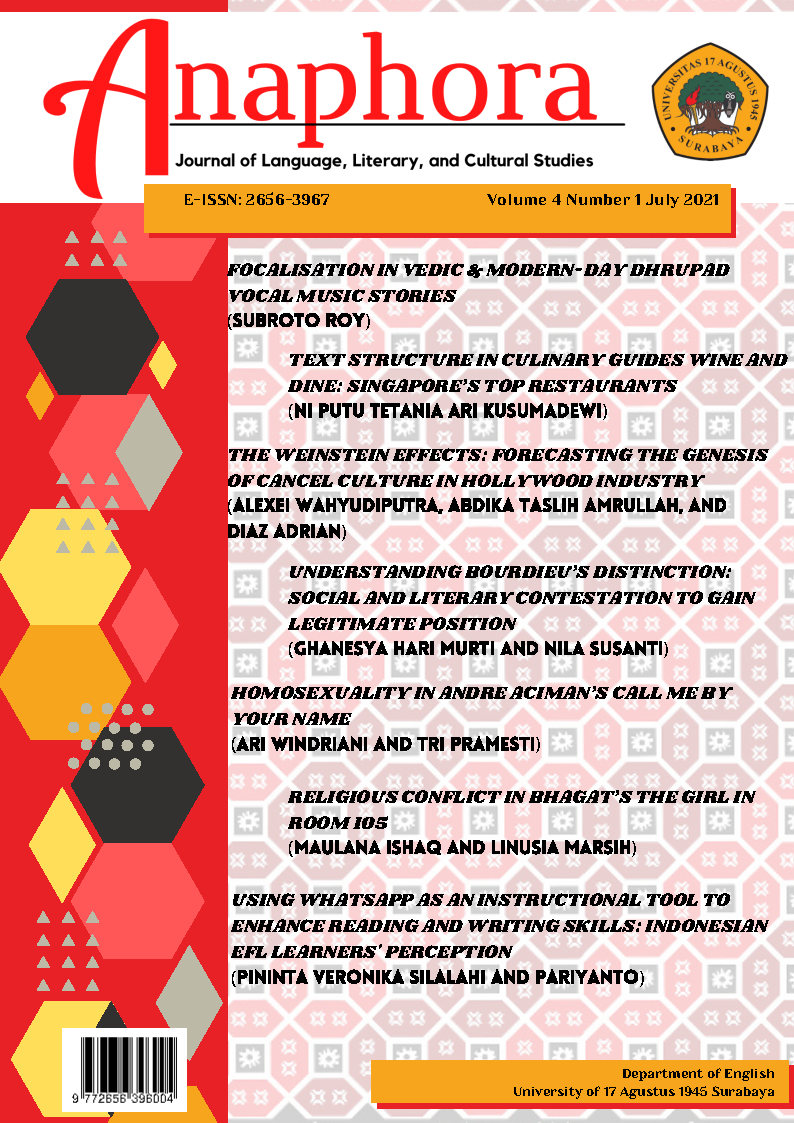THE WEINSTEIN EFFECTS: FORECASTING THE GENESIS OF CANCEL CULTURE IN HOLLYWOOD INDUSTRY
DOI:
https://doi.org/10.30996/anaphora.v4i1.4710Keywords:
Cancel culture, celebrity culture, Weinstein Effects, Cultural StudiesAbstract
The phenomenon of cancel culture has become a common, even effective, way of convicting people who are deemed to be a deviant of social norms. The practice of cancel culture is massively emerging on mainstream lens by the stimulation of Harvey Weinstein’s cases in Hollywood discourse, or known as the Weinstein Effects. The article aims to examine cancel culture in Hollywood and the relation between this phenomenon with Weinstein Effects, and point out a hysteresis in Hollywood celebrity culture due to this event. The research is conducted qualitatively by synthesizing information from various journal articles and online news regarding celebrity discourse. Furthermore, the basis of analytical discussion within this article is Foucauldian premise regarding genealogy and Bourdieusian postulation on cultural hysteresis.Downloads
References
Bazelon, E. (2014). Sticks and stones: defeating the culture of bullying and rediscovering the power of character and empathy. Choice Reviews Online. https://doi.org/10.5860/choice.51-7030
Bevir, M. (2008). What is genealogy? Journal of the Philosophy of History, 2(3), 263–275.
Bhattacharyya, R. (2018). # Metoo Movement: An Awareness Campaign. International Journal of Innovation, Creativity and Change, 3(4).
Bouvier, G. (2020). Racist call-outs and cancel culture on Twitter: The limitations of the platform’s ability to define issues of social justice. Discourse, Context & Media, 38, 100431.
Caramanica, J. (2020). This ‘Imagine’ Cover Is No Heaven. Retrieved February 5, 2021, from New York Times website: https://www.nytimes.com/2020/03/20/arts/music/coronavirus-gal-gadot-imagine.html
Citron, D. K. (2014). Hate Crimes in Cyberspace. In Hate Crimes in Cyberspace. https://doi.org/10.4159/harvard.9780674735613
Farrow, R. (2017). From Aggressive Overtures to Sexual Assault: Harvey Weinstein’s Accusers Tell Their Stories. Retrieved February 1, 2021, from The New Yorker website: https://www.newyorker.com/news/news-desk/from-aggressive-overtures-to-sexual-assault-harvey-weinsteins-accusers-tell-their-stories
Furedi, F. (2010). Celebrity Culture. Society. https://doi.org/10.1007/s12115-010-9367-6
Grenfell, M. J. (2014). Pierre Bourdieu: key concepts. London: Routledge.
Hanukov, I. (2015). The “Cocaine Kate” Scandal: Celebrity Addiction or Public Addiction to Celebrity? Journal of Popular Culture. https://doi.org/10.1111/jpcu.12299
Hunter, E. J., Henri Burgers, J., & Davidsson, P. (2009). Celebrity capital as a strategic asset: Implications for new venture strategies. Advances in Entrepreneurship, Firm Emergence and Growth. https://doi.org/10.1108/s1074-7540(2009)0000011007
Hurd, P. W. S. J. J. C. G. (1990). Common Culture: Symbolic Work at Play in the Everyday Cultures of the Young. Milton Keynes: Open University Press.
Jenkins, H. (2006). Fans, bloggers, and gamers: Exploring participatory culture (New York U). New York.
Klonick, K. (2015). Re-shaming the debate: Social norms, shame, and regulation in an internet age. Md. L. Rev., 75, 1029.
Kohm, S. A. (2009). Naming, shaming and criminal justice: Mass-mediated humiliation as entertainment and punishment. Crime, Media, Culture, 5(2), 188–205.
Lull, J., & Hinerman, S. (1997). The search for scandal. In Media scandals: Morality and desire in the popular culture marketplace.
Maltby, J., Day, L., McCutcheon, L. E., Martin, M. M., & Cayanus, J. L. (2004). Celebrity worship, cognitive flexibility, and social complexity. Personality and Individual Differences. https://doi.org/10.1016/j.paid.2004.02.004
Müller, T. R. (2013). The Long Shadow of Band Aid Humanitarianism: Revisiting the dynamics between famine and celebrity. Third World Quarterly. https://doi.org/10.1080/01436597.2013.785342
O’Neil, A., Sojo, V., Fileborn, B., Scovelle, A. J., & Milner, A. (2018). The# MeToo movement: an opportunity in public health? The Lancet, 391(10140), 2587–2589.
PettyJohn, M. E., Muzzey, F. K., Maas, M. K., & McCauley, H. L. (2019). # HowIWillChange: Engaging men and boys in the# MeToo movement. Psychology of Men & Masculinities, 20(4), 612.
Raffnsøe, S., Thaning, M. S., & Gudmand-Hoyer, M. (2016). Michel Foucault: A research companion. New York: Springer.
Romano, A. (2019). Why we can’t stop fighting about cancel culture. Retrieved February 3, 2021, from Vox website: https://www.vox.com/culture/2019/12/30/20879720/what-is-cancel-culture-explained-history-debate
Sills, S., Pickens, C., Beach, K., Jones, L., Calder-Dawe, O., Benton-Greig, P., & Gavey, N. (2016). Rape culture and social media: Young critics and a feminist counterpublic. Feminist Media Studies, 16(6), 935–951.
Skoric, M. M., Chua, J. P. E., Liew, M. A., Wong, K. H., & Yeo, P. J. (2010). Online shaming in the Asian context: Community empowerment or civic vigilantism? Surveillance & Society, 8(2), 181–199.
Stever, G. S. (2011). Celebrity Worship: Critiquing a Construct. Journal of Applied Social Psychology. https://doi.org/10.1111/j.1559-1816.2011.00765.x
Stever, G. S., & Lawson, K. (2013). Twitter as a way for celebrities to communicate with fans: Implications for the study of parasocial interaction. North American Journal of Psychology.
Tippett, E. C. (2018). The Legal Implications of the MeToo Movement. Minn. L. Rev., 103, 229.
van Krieken, R. (2012). Celebrity Society. In Celebrity Society. London: Routledge. https://doi.org/10.4324/9781315100814
Wolff, M. (2017). Harvey Weinstein: Everyone knew. Retrieved February 5, 2021, from GQ website: https://www.gq-magazine.co.uk/article/harvey-weinstein-everyone-knew
Downloads
Additional Files
Published
How to Cite
Issue
Section
License
Authors whose manuscript is published will approve the following provisions:
-
The right to publication of all journal material published on the jurnal anaphora website is held by the editorial board with the author's knowledge (moral rights remain the property of the author).
-
The formal legal provisions for access to digital articles of this electronic journal are subject to the terms of the Creative Commons Attribution-ShareAlike (CC BY-SA) license, which means Jurnal Persona reserves the right to store, modify the format, administer in database, maintain and publish articles without requesting permission from the Author as long as it keeps the Author's name as the owner of Copyright.
-
Printed and electronic published manuscripts are open access for educational, research and library purposes. In addition to these objectives, the editorial board shall not be liable for violations of copyright law.















